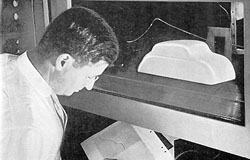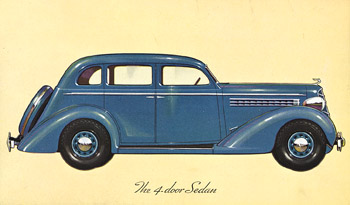|
by Dave Duricy |
||||||
|
DeStreamliner
|
||||||
| DeStart | DeStreamliner | DeSuccess | DeSupply | DeSpeed | DeStuff | DeStop | ||||||
Wind tunnel testing began in 1927. Chrysler engineers discovered that contemporary automobiles moved more efficiently through the air with the body reversed. Hence the "backwards" DeSoto Hartz drove. The revelation prompted an ambitious quest for the ideal aerodynamic body that would save gasoline and increase speed. The search would inspire a fundamental re-evaluation of car design, and bring true modernity to motoring. The result was the 1934 DeSoto Airflow, DeSoto's boldest adventure. "Goodbye 'Horseless Carriage,'" shouted DeSoto advertising, "Here's the New Airflow DeSoto!" Airflow styling said, "Woosh!" Blown away were free-standing headlights, radiator shells, side-mounted spare tires, and bobbed tails. In their place was a svelte, envelope body whose lines slithered fore and aft in a relaxed arch. Most radical was the front, whose waterfall grille simply let the wind pass so that the car may go faster. Sleekness was only part of the package. The DeSoto Airflow concealed a revolutionary chassis with the interior moved 20 inches forward. Correspondingly, the engine compartment was placed between rather than behind the front wheels. Not only did this new configuration cradle passengers within the wheelbase, but it reversed traditional weight distribution for a front end bias, eliminating fore and aft pitching and reducing rebound motion by 20%. The result was a smooth "amidships ride." It's an arrangement most new cars have followed ever since. DeSoto promotions liked to say that an Airflow passenger could comfortably read his newspaper while the driver navigated a dirt road at 80mph. DeSoto was so confident of Airflow's on-road stability that hand straps were purposefully eliminated from the cabin. The interior was among the most luxurious and safest in the world. Beautifully upholstered seats set in chrome frames offered the industry's first comfortable six passenger capacity. Ventilation was outstanding due to airspace beneath the front seats, elaborate dual action windows in the front doors, twin cowl vents and crank out windshields. Being cool and comfortable meant the Airflow driver could better appreciate the ergonomically angled steering wheel that allowed shoulders to relax.
Airflow design propelled DeSoto to 32 stock car records. Airflow scorched the flying mile at 86.2 miles per hour, averaged 80.9 miles per hour for 100 miles, 76.2 miles per hour for 500 miles, and 74.7 miles per hour for 2,000 miles. For gravy, Harry Hartz drove a DeSoto Airflow 3,114 miles from New York to San Francisco. The DeSoto averaged 21.4mpg. with a total gas bill of $33.06. With the Airflow, Walter Chrysler made the cover of Time. The January 8, 1934 issue captioned the industrialist's portrait with the catchy line, "He made the buggy a bugaboo." Inside, a curiously staged interview asked Mr. Chrysler of the Airflow, "Do you think the public is ready for anything so radical?" Mr. Chrysler responded, "I know the public is always ready for what it wants... and the public is always able to recognize genuine improvement." True, the public did recognize that the DeSoto Airflow was a genuine improvement - in Europe. The DeSoto Airflow was a hit overseas. The Monte Carlo Concours d'Elegence presented DeSoto with the Grand Prix award for aerodynamic styling. European manufactures, such as Peugeot, Renault, and Volvo, went so far as to copy the Airflow look for their production cars. More remarkable is that in distant Japan the first mass produced Toyota was styled to resemble the '34 DeSoto. DeSoto promoted the Airflow hard at the 1934 "Century of Progress" World's Fair in Chicago. Babe Ruth, Dick Powell, Ruby Keeler and Ethyl Merman all made various celebrity appearances on behalf of the car, too. The American driver, however, wasn't buying. 1934 DeSoto deliveries declined 47% and only 13,940 Airflows were built for the model year. DeSoto fell from 10th to 13th place in the industry. One Airflow brochure called style a state of mind. Clearly, consumers were thinking of something else.
DeSoto acquiesced to the public's dislike for the Airflow and fielded a conventionally styled and engineered Airstream companion series for 1935. Each succeeding model year, the Airflow itself wore a more pronounced art-deco nose trying to disguise its unorthodox profile. In 1936, the Airflow line was canceled. |
||||||
| DeStart | DeStreamliner | DeSuccess | DeSupply | DeSpeed | DeStuff | DeStop | ||||||


